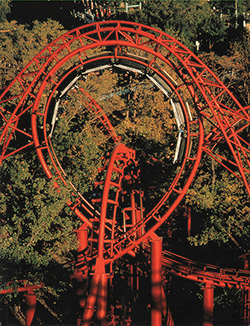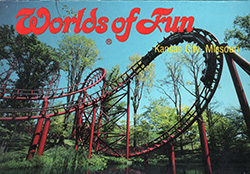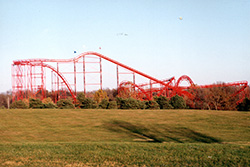Orient Express |

|
Statistics: Manufacturer: Arrow Development Model Type: Custom Multi-Looper Track Length: 3,470 feet Theoretical Capacity: 1,800 an Hour All Time Maximum Capacity: 2,211 an Hour Numbers of Trains: 3 Cars per Train: 7 Maximum Speed: 65 mph Maximum Height: 12 Stories First Drop Height: 115 feet First Loop Height: 80 feet Second Loop Height: 60 feet Duration: 2 mins, 30 seconds Number of Inversions: 4 (2 vertical loops, 1 boomerang) |
Orient Express opened on April 4, 1980, as the largest tubular steel coaster in the world. Built by Arrow Development of Mountainview, Ca. and designed by Ron Toomer, Express would be a true technological marvel of its day. Five years prior, Arrow had introduced the first modern coaster to take riders upside down, the Corkscrew at Knott's Berry Farm. In 1976, Arrow would open Corkscrew at Cedar Point, their first coaster to introduce the vertical loop. The final piece of the puzzle leading to Express was the 1978 opening of Loch Ness Monster at Busch Gardens Williamsburg, the first coaster, and today only operating coaster, with interlocking loops. Lamar Hunt and Mid-America Enterprises took note. They were looking for the next major investment for the park and liked what they saw. With the $4 million investment, Arrow would take the next step in the roller coaster revolution and introduce what could be considered their first multi-looper, the first coaster with an inversion other than a loop or corkscrew.
It would be called the Kamikaze Kurve by the park, a combination of corkscrew and loop, equal parts of each but at the same time, something completely new. Today, the Kamikaze Kurve is an often re-produced element on steel coasters, know more commonly as the "boomerang" or "batwing". Though the element has been perfected over the years, today's modern versions of the element are still very similar to the original on Express. All enter the element through a half-corkscrew, merge into a loop, before exiting with a second half loop, half corkscrew, moving exactly the opposite direction in which it entered the element in the first place. What has drastically changed is the overall proportion of the element to the rest of the ride. With the Kamikaze Kurve the element is dwarfed by the rest of the ride structure, where on more modern versions the opposite is true. Kamikaze Kurve almost seemed shoe-horned into its space, a trait shared by only one other ride, the Vortex at Kings Island.

The Kamikaze Kurve and Express's two interlocking loops would offer riders four upside-down elements, but they were only a portion of the experience. From beginning to end the execution was near flawless for the time, a 100-foot ominous and echoing tunnel to start, the first 115-foot, gut-wrenching drop, the two other smaller, yet no less intense drops into the tangled loops standing 60 and 80 feet above the ground, the Kamikaze Kurve, the out of control helix and the trees, seemingly so close. Overall, it made for an intense 2-1/2 minute joy ride, especially when riders considered the next closest contenders, Screamroller, was less than half the run time, and Zinger clocked in at 20 mph slower.
Orient Express was announced to the world on November 19, 1979, and General Manager at the time Lee Derrough commenting on the new plans for Express stated "Cost really didn't become a factor in our research - we weren't even that concerned about setting records for size and speed. We just wanted the build the best ride, one in which there were the most thrills per minute, and one in which there were no slow spots" (Ball, 1979). Most will agree Express wasn't a coaster one would think of when it came to slow spots, and for not being designed to be a record-breaker it sure did quite a good job at being one, as it was described in the official park press release as the "largest of its kind in the world" (Worlds of Fun, 1980).
Orient Express would open to the public to great fanfare on April 4, 1980, complete with as the Independence Examiner stated "a dixieland band, dedication speeches, and ceremonial gongs" (Orient Express premiered at Worlds of Fun April 4th, 1980). Jeff Mast, one of our editors was there that day, and was on the first public train, hearing not only the previously mentioned gong sound but also receiving a ceremonial "first rider" certificate. He was one of over 20,000 rides that the Orient Express gave that day, and rode along with a few quasi-celebrities (climber George Willig and aeronaut Larry Newman), and park leadership, General Manager Lee Derrough, President Jack Steadman, and Vice President of engineering for Arrow, Peter Gacs.
It was readily apparent on the day it opened and the 23 subsequent years of its operation that Express wasn't just any old coaster. It was specifically designed into a natural valley. While it was visible from anywhere in the park, it unlike Mamba almost goaded its victims into believing it wasn't that bad, simply because much of it, like Zinger, was hidden in a valley by a forest of trees. Designer of Orient Express Ron Toomer stated it best "The Orient Express was designed to correspond with the existing ground layout, preserving as many trees and natural features as possible... We were commissioned by Worlds of Fun to design a major coaster which not only provides an exciting ride experience, but a spectacular visual effect" (Conjuring up the Orient Express, 1980).
The theming was meticulous too, complete with Chinese-inspired station and surrounding gardens and ponds, there wasn't a switchback rail to be seen anywhere in its queue line. Its name, inspired by the Agatha Christie novel "Murder on the Orient Express" was a perfect fit, but almost got the park into hot water with the operators of the real Orient Express railway. It was reported by the Kansas City Star on January 19, 1992 that the French company that operated the Orient Express passenger train in Europe, Society Nationale De Chemins De For Francais had filed a lawsuit with the US District Court in Kansas City contending that "Hunt Midwest's use of the Orient Express name creates an erroneous impression on the consuming public" (Heaster, 1992). The charges were later dropped but it added a unique backstory to this rides name.
Another infamous backstory to Orient Express was its accident on June 14, 1987. With one train sitting in the trim brakes directly outside of the station, a second train, running about 10-15 miles per hour collided with it. This occurred as the first train stopped in the trim brakes as usual, but then the brakes would not release and allow the train to enter the station. Nine riders were injured, one was hospitalized. Many point to this moment as the beginning of the downfall of Orient Express. However, as Arrow, the manufacturer of Orient Express was still to open its four great multi-loopers, the direct successors of Orient Express, Vortex in 1987 (Kings Island), Shockwave in 1988 (Six Flags Great America), Great American Scream Machine in 1989 (Six Flags Great Adventure ). And Viper in 1990 (Six Flags Magic Mountain) the argument that a relatively minor accident was the downfall to a ride in which was still holding its own among some of the biggest and tallest coasters of the time is fairly difficult to believe.
What was the beginning downfall of Orient Express would come five years later, and had nothing to do with an accident but everything to do with the rideability of Orient Express, and most of the Arrow Coasters. While Arrow was a great innovator of coaster designs, having arguably created the entire modern amusement industry, they stumbled when it came to perfecting their creations. Most remember Orient Express for a terrifying ride full of great drops, disorienting inversions, and the painful pounding of their head on the shoulder harness. Orient Express was never smooth as silk, no Arrow coaster was or has ever been so. Bolliger & Mabillard of Switzerland (B&M) figured out a way to fix the problem caused by a solid steel axle, by creating an independent steering wheel boggie, and in doing so created a smooth experience. The world would change when their first inverted coaster, Batman would open in 1992 at Six Flags Great America.

Orient Express hung on though and was still incredibly popular far into the '90s. The end of the Orient Express would start on the night of July 17, 1999. Orient Express derailed in its final helix leaving the last two cars dangling from the track. Thirteen were reported as injured, though no one severely. Though Express was ready to run before the end of the 1999 season it would not open again until opening day of the 2000 season, April 8th. At the time, most park patrons were thrilled to have Express back, and with a new bright red paint job too! However, Express would only operate for four more seasons, and spend more and more time down for maintenance with each passing season. Unknowingly to its riders at the time, Express would give its last public ride sometime in September 2003. On November 6, 2003, the news broke not from the park but an enthusiast on the forums on www.worldsoffun.org who had noticed a piece of track was missing near the mid-course brake. Demolition of Express had begun, and it took only a few weeks for it to be removed forever from the Worlds of Fun skyline.
Orient Express's long term impact on the park can never be discounted, from the day it opened, it propelled the park from regional theme park to the national stage and made Worlds of Fun a real player for many years after it opened. The fact that for many including Kansas City Star reporter Nancy Ball's first opinion of Express was "You're not going to get me on that thing!" (Ball, 1980) Proves how great a job both Arrow and it's designer Ron Toomer did at conceiving one of the greatest scream machines of the 1980s, possibly ever.
Relevant Links and Sources
1980 Worlds of Fun Brochure: http://www.worldsoffun.org/history/publications/1980brochure.pdf
1980 Great Times: http://www.worldsoffun.org/history/publications/1980goodtimes_sml.pdf
Photos
YouTube Videos
Orient Express (on-ride) Coaster Con 1993
1996 Orient Express